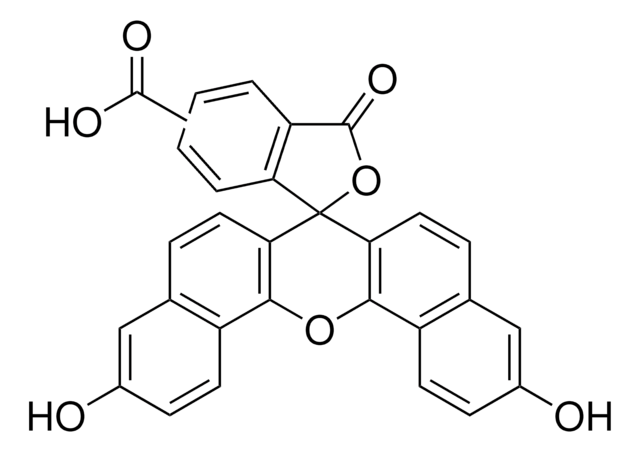21877
5(6)-Carboxyfluorescein
suitable for fluorescence, BioReagent, ≥95% (HPLC)
Synonim(y):
5(6)-FAM, 5,6-CF
About This Item
Polecane produkty
linia produktu
BioReagent
Próba
≥95% (HPLC)
Postać
powder
mp
275 °C (dec.) (lit.)
fluorescencja
λex 492 nm; λem 517 nm in 0.1 M Tris pH 8.0
przydatność
suitable for fluorescence
ciąg SMILES
OC(=O)c1ccc2c(c1)C(=O)OC23c4ccc(O)cc4Oc5cc(O)ccc35.OC(=O)c6ccc7C(=O)OC8(c9ccc(O)cc9Oc%10cc(O)ccc8%10)c7c6
InChI
1S/2C21H12O7/c22-11-2-5-15-17(8-11)27-18-9-12(23)3-6-16(18)21(15)14-4-1-10(19(24)25)7-13(14)20(26)28-21;22-11-2-5-14-17(8-11)27-18-9-12(23)3-6-15(18)21(14)16-7-10(19(24)25)1-4-13(16)20(26)28-21/h2*1-9,22-23H,(H,24,25)
Klucz InChI
BPVHBBXCESDRKW-UHFFFAOYSA-N
Szukasz podobnych produktów? Odwiedź Przewodnik dotyczący porównywania produktów
Powiązane kategorie
Opis ogólny
- It has 2 wavelengths for maximum absorbance (465 and 490nm).
- And its fluorescence emission, at 515nm(max.), increases as a function of pH in the physiological range of 6-7.4.
Zastosowanie
Inne uwagi
Kod klasy składowania
11 - Combustible Solids
Klasa zagrożenia wodnego (WGK)
WGK 3
Temperatura zapłonu (°F)
Not applicable
Temperatura zapłonu (°C)
Not applicable
Środki ochrony indywidualnej
Eyeshields, Gloves, type N95 (US)
Certyfikaty analizy (CoA)
Poszukaj Certyfikaty analizy (CoA), wpisując numer partii/serii produktów. Numery serii i partii można znaleźć na etykiecie produktu po słowach „seria” lub „partia”.
Masz już ten produkt?
Dokumenty związane z niedawno zakupionymi produktami zostały zamieszczone w Bibliotece dokumentów.
Klienci oglądali również te produkty
Produkty
Nitric oxide (NO) as a signal transporter in neurons, endothelial cells and in the immune system.
Nasz zespół naukowców ma doświadczenie we wszystkich obszarach badań, w tym w naukach przyrodniczych, materiałoznawstwie, syntezie chemicznej, chromatografii, analityce i wielu innych dziedzinach.
Skontaktuj się z zespołem ds. pomocy technicznej












